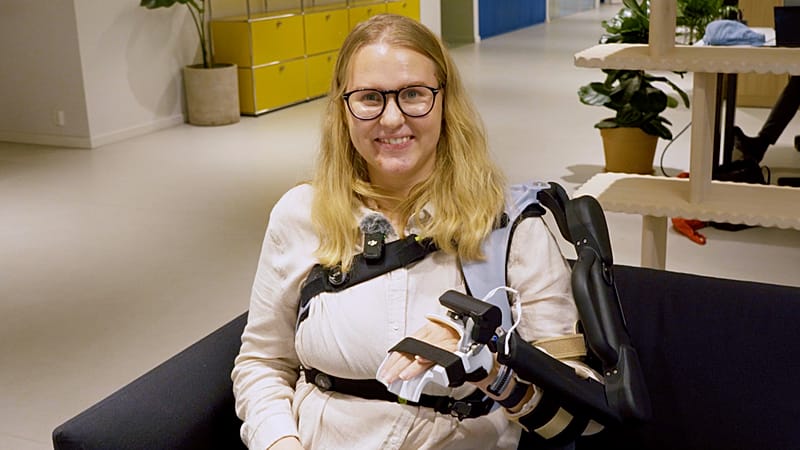This is the world’s first entire arm exoskeleton, giving stroke patients more ‘independence'

In 2017, Norwegian student Johanne Marie Hemnes suddenly collapsed in her living room. She was paralysed on her left side, and doctors found a brain haemorrhage, bleeding inside her brain.
Eight years on, the 26-year-old has learned to walk again after months of rehabilitation that focused mainly on her leg. Her arm, however, received little attention and never regained full movement.
“Almost all of the focus was on my leg to get better so that I could walk and my arm was like completely [neglected], just didn't think of it at all,” Johanne Marie Hemnes, a stroke survivor and an occupational therapist at Vilje Bionics, told Euronews Health.
She even wished she could have it removed after repeatedly bruising it by walking into doors.
“[I felt like] just cutting it off because it was like more in the way than it was helping me”.
One in four people suffers a stroke during their lifetime, according to the World Stroke Organisation.
People living with paresis - partial or incomplete paralysis - have limbs that remain intact, but nerve signals no longer work properly.
The founders of a Norwegian bionic arm start-up, Vilje Bionics, say stroke survivors have limited options for assistive devices, in contrast to bionic prosthetic arms for amputees.
“These people need help to be self-reliant, live at home, get back to work and get more opportunities in their life just like anybody else,” said Saeid Hosseini, Vilje Bionics CEO and Co-founder.
Vilje Bionics is developing a robotic arm for people with reduced mobility due to spinal cord injury, traumatic brain injury or neuromuscular diseases.
Earlier this year, Hemnes tried the 3D-printed exoskeleton and later joined the Norwegian start-up.
“I call my arm Jenny, because it feels like it's not a part of me, because it doesn't do what I want it to do. But when I actually have this on, it feels like me again. It doesn't just feel like another human being's arm,” she said.
World’s first exoskeleton for the entire arm
Vilje Bionics' robotic arm assists movements for the shoulder, elbow and hand, which makes it the world’s first exoskeleton for the entire arm.
Until now, exoskeletons for those with paretic arms covered only up to the elbow and used sensors on the skin. Vilje Bionice’s prototype called Vilpower uses a novel sensor technology that doesn’t need skin contact.
Most users retain small arm motions, which the device ‘amplifies’. The developers behind the device say it works by the user “thinking how they would move their arm”.
“Because if you think, you make a small movement and then it amplifies that movement,” Hosseini said.
“It detects very small movements of a residual movement of a paretic arm and amplifies those movements,” he added.
The robotic arm may be used for rehabilitation purposes in the future, but the company is currently focusing on helping “patients with lasting and significant disabilities to be more independent”.
More than 40 patients have trialled the robotic arm during the development phase so far.
The prototype is now in the final stages of product completion and the company hopes to launch the robotic arms within four to six months, starting in Norway. t
Since Hemnes started to trial the bionic arm, she has been practising cutting vegetables and opening bottles. She says she is excited to try cooking one day.
“I still find like new features every day because I haven't done two-arm activities in eight years…it's like whole brain training again to figure out how to use both arms. But it's so fun using it,” Hemnes said.
Typically, it takes two to three months of training to get used to the robotic arm, according to its developers.
Johanne says she feels like Jenny is slowly disappearing and is “more of Johanne now”.
For more on this story, watch the video in the media player above.

